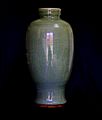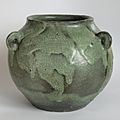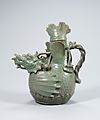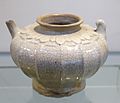Celadon facts for kids
Celadon is a special term used for ceramics, which are objects made from clay and then hardened by heat. It refers to both a unique type of glaze (a shiny coating on pottery) and the beautiful color this glaze creates. Celadon pottery often has a lovely green or bluish-green color, like jade.
Contents
The Story of Celadon Pottery
Celadon pottery first appeared in China many, many years ago. It became very popular during different Chinese dynasties, especially the Song Dynasty (960–1279 AD). Potters in places like the Longquan kiln in Zhejiang province were famous for making incredible celadon pieces.
How Celadon Got Its Start
The earliest celadon glazes were developed in China around the 2nd century AD. Potters discovered how to make a special glaze that would turn green when fired in a very hot kiln (a type of oven for pottery). This green color came from tiny amounts of iron in the clay and glaze. When heated in a low-oxygen environment, the iron turned green.
Celadon's Journey Across Asia
Over time, the amazing art of making celadon spread from China to other regions in Asia. Countries like Japan, Korea, and Thailand learned the techniques and started making their own beautiful celadon pottery. Each country added its own unique style and designs to the celadon tradition.
Korean Celadon: A Special Style
In Korea, during the Goryeo Dynasty (918–1392 AD), celadon reached new heights. Korean potters developed a special technique called sanggam. This involved carving designs into the clay, filling the carvings with white or black clay slip, and then covering it with the celadon glaze. This created stunning inlaid patterns, often featuring cranes, clouds, or flowers.
Japanese and Thai Celadon
Japan also adopted celadon techniques, creating elegant pieces often used in tea ceremonies. In Thailand, particularly in the Sukhothai Kingdom and Lanna Kingdom, celadon production flourished. Thai celadon often featured unique patterns and shapes, showing the local artistic touch.
The Magic Behind Celadon's Color
The distinctive color of celadon comes from the way it's made. The glaze contains a small amount of iron oxide. During the firing process in the kiln, the temperature is very high, and the amount of oxygen inside the kiln is carefully controlled. This special environment causes the iron to change, creating the beautiful range of greens, blues, and even brownish-greys that celadon is known for.
Why So Many Shades of Green?
The exact shade of celadon depends on several things:
- The amount of iron in the glaze.
- The specific temperature of the kiln.
- How much oxygen is in the kiln during firing.
- The type of clay used for the pottery itself.
This is why you can see celadon pieces that are a pale, misty green, a deep olive green, or even a soft, sky-blue color. Each piece is unique!
Images for kids
-
Yaozhou ware bowl with carved and combed decoration, Northern Song dynasty
-
Narcissus basin with light bluish-green glaze, Ru ware, National Palace Museum.
-
Censer with kingfisher glaze, Goryeo Dynasty (National Treasure No. 95)
-
Yue ware bowl, 3rd century CE, Western Jin, Zhejiang.
-
Ru ware bowl, with metal rim, produced exclusively for the Northern Song emperors c. 1110–1125.
-
Guan ware, Southern Song dynasty, 1100s–1200s AD
-
Longquan celadon from Zhejiang, Ming Dynasty, 14–15th century
-
Celadon Buddhist ritual sprinkler with phragmites and wild goose design in relief
-
Teapot, Lý dynasty period, 11th-12th century
-
Green celadon jar, Trần dynasty period, 14th century
See also
 In Spanish: Celadón para niños
In Spanish: Celadón para niños














































